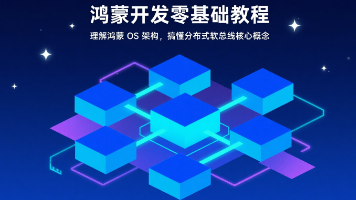鸿蒙特性《跨设备数据同步:分布式数据库保存游戏进度》(新手友好版)
鸿蒙分布式数据库通过注解标记可同步的数据对象。首先创建一个// GameProgress.ets(数据模型)// 使用@Distributed注解标记可同步的数据对象@distributedDataObject.Distributed(scope = distributedDataObject.Scope.GLOBAL) // 全局可见// 玩家金币数// 玩家等级// 装备列表(示例用字符串数组
在鸿蒙(HarmonyOS)设备(如手机、平板、智慧屏)上开发游戏时,玩家常希望“在手机上玩到一半,平板上能继续”——这需要跨设备数据同步。鸿蒙的分布式数据库(Distributed Data Object, DDO)正是解决这一问题的核心技术:它基于分布式软总线,让不同设备像“共享同一个硬盘”一样同步数据。本文将以“保存/加载游戏进度”为例,手把手教你用鸿蒙分布式数据库实现跨设备数据同步,全程无复杂术语,新手也能轻松上手!
一、为什么选择鸿蒙分布式数据库?
传统游戏数据同步需自己搭建服务器或使用第三方云服务,而鸿蒙分布式数据库的优势在于:
- 无需额外服务器:利用设备间的分布式软总线直接通信;
- 自动同步:数据修改后,其他设备自动感知并更新;
- 跨端兼容:手机、平板、PC等设备统一API,一套代码搞定。
二、环境准备:从0到1搭建开发环境
1. 安装必要工具
- DevEco Studio:鸿蒙应用开发IDE(下载地址:DevEco Studio-鸿蒙应用集成开发环境(IDE)-华为开发者联盟);
- 鸿蒙SDK:在DevEco Studio中安装“HarmonyOS SDK”(版本≥API 9,支持分布式数据库)。
2. 配置游戏项目
新建一个鸿蒙“Empty Ability”项目(API 9+),并在entry/src/main/module.json5中声明分布式能力:
{
"module": {
"reqPermissions": [
// 声明需要访问分布式数据库的权限
{ "name": "ohos.permission.DISTRIBUTED_DATASYNC" }
],
"deviceTypes": ["phone", "tablet"] // 支持手机和平板
}
}三、核心步骤:用分布式数据库保存游戏进度
我们以“保存玩家金币、等级、装备”为例,分四步实现跨设备同步。
步骤1:定义游戏进度数据结构(鸿蒙原生代码)
鸿蒙分布式数据库通过@Distributed注解标记可同步的数据对象。首先创建一个GameProgress类,描述游戏进度:
// GameProgress.ets(数据模型)
import distributedDataObject from '@ohos.data.distributedDataObject';
// 使用@Distributed注解标记可同步的数据对象
@distributedDataObject.Distributed(scope = distributedDataObject.Scope.GLOBAL) // 全局可见
export class GameProgress {
// 玩家金币数
coins: number = 0;
// 玩家等级
level: number = 1;
// 装备列表(示例用字符串数组)
equipments: string[] = [];
// 构造函数(可选)
constructor(coins?: number, level?: number, equipments?: string[]) {
this.coins = coins ?? 0;
this.level = level ?? 1;
this.equipments = equipments ?? [];
}
}步骤2:初始化分布式数据库(鸿蒙原生代码)
在游戏中需要访问分布式数据库时,初始化DistributedDataManager并获取GameProgress对象:
// GameManager.ets(游戏管理器)
import distributedDataObject from '@ohos.data.distributedDataObject';
import { GameProgress } from './GameProgress';
@Entry
@Component
struct GameManager {
// 获取全局唯一的分布式数据对象(通过类名)
private gameProgress: GameProgress = distributedDataObject.getGlobalObject(GameProgress);
// 保存进度到分布式数据库(关键方法)
saveProgress(coins: number, level: number, equipments: string[]) {
// 更新数据
this.gameProgress.coins = coins;
this.gameProgress.level = level;
this.gameProgress.equipments = equipments;
// 提交修改(触发跨设备同步)
this.gameProgress.flush(); // 强制同步到云端/其他设备
}
// 从分布式数据库加载进度(关键方法)
loadProgress(): { coins: number, level: number, equipments: string[] } {
// 直接读取已同步的数据(首次加载可能为空,需处理默认值)
return {
coins: this.gameProgress.coins,
level: this.gameProgress.level,
equipments: this.gameProgress.equipments
};
}
}步骤3:在游戏界面中调用保存/加载(ArkTS)
在游戏的主界面中,添加“保存进度”和“加载进度”按钮,并绑定上述方法:
// Index.ets(游戏主界面)
import GameManager from './GameManager';
@Entry
@Component
struct GameMain {
private gameManager = new GameManager();
@State private coins: number = 0;
@State private level: number = 1;
@State private equipments: string[] = [];
build() {
Column() {
// 显示当前游戏进度
Text(`金币:${this.coins}`).fontSize(24)
Text(`等级:${this.level}`).fontSize(24)
Text(`装备:${this.equipments.join(', ')}`).fontSize(24)
// 模拟游戏操作(赚金币、升级)
Button('赚10金币')
.onClick(() => {
this.coins += 10;
})
Button('升1级')
.onClick(() => {
this.level += 1;
})
// 保存进度按钮
Button('保存进度到云端')
.onClick(() => {
this.gameManager.saveProgress(
this.coins,
this.level,
this.equipments
);
promptAction.showToast({ message: '保存成功!' });
})
// 加载进度按钮
Button('从云端加载进度')
.onClick(() => {
const progress = this.gameManager.loadProgress();
this.coins = progress.coins;
this.level = progress.level;
this.equipments = progress.equipments;
promptAction.showToast({ message: '加载成功!' });
})
}
}
}步骤4:测试跨设备同步(手机+平板)
- 设备准备:确保手机和平板登录同一华为账号,且开启“超级终端”(设置→超级终端→开启多设备协同);
- 部署应用:在DevEco Studio中,将应用同时安装到手机和平板;
- 测试流程:
- 在手机上点击“赚10金币”→“保存进度到云端”;
- 切换到平板,点击“从云端加载进度”,观察金币数是否同步;
- 在平板上修改等级→保存,再回到手机加载,验证双向同步。
四、常见问题与解决方案(新手避坑)
Q1:数据同步失败,提示“设备未连接”?
- 原因:设备未开启分布式软总线或未加入同一超级终端;
- 解决:
- 检查手机/平板是否开启“超级终端”(设置→超级终端→开启);
- 手动将设备“拉近”(如手机靠近平板),触发自动连接。
Q2:首次加载进度为空?
- 原因:分布式数据库首次使用时,其他设备尚未同步数据;
- 解决:
- 先在“源设备”(如手机)保存一次进度;
- 其他设备需等待几秒(数据同步需要时间),或手动刷新。
Q3:数据修改后未自动同步?
- 原因:未调用
flush()方法强制同步; - 解决:在修改数据后,务必调用
gameProgress.flush()(如保存按钮的点击事件中)。
更多推荐
 已为社区贡献40条内容
已为社区贡献40条内容







所有评论(0)